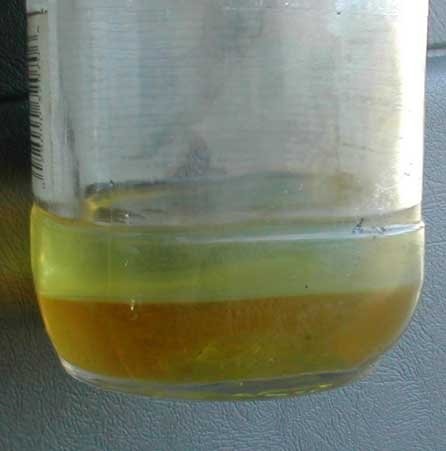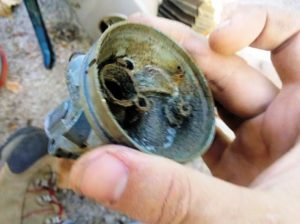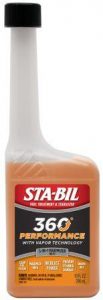What are the Effects of Ethanol in Gasoline and How to Protect your Engines Against it?
Most of the gasoline sold today in the United States contains ethanol, and the percentage is expected to increase over the next few years. Gasoline and ethanol are delivered to the gas stations separately and are blended together at gas stations during delivery. So what are the effects of ethanol in gasoline, and what can you do to prolong the life of your engines running on ethanol-blended fuel?
The Potential Problems
 Ethanol is added to gasoline as mandated by the EPA to lower carbon emissions to make running of such engines more eco-friendly. Ethanol-blended fuels left untreated can start “phasing.” Phase separation is when ethanol in the fuel absorbs too much water, and separates from gasoline by dropping to the bottom of the tank since the ethanol and water mixture that results from phase separation is heavier than gasoline. Water-ethanol solutions can damage fuel systems and engines, and the system will need to get flushed to prevent further damage. Once phase separation has occurred, no additive can reverse it, and the fuel tank will require draining. If the fuel and ethanol have completely phase-separated, the fuel in the tank will be unusable and must be drained. Mechanics offer ‘pump-out’ services to drain and flush the fuel system.
Ethanol is added to gasoline as mandated by the EPA to lower carbon emissions to make running of such engines more eco-friendly. Ethanol-blended fuels left untreated can start “phasing.” Phase separation is when ethanol in the fuel absorbs too much water, and separates from gasoline by dropping to the bottom of the tank since the ethanol and water mixture that results from phase separation is heavier than gasoline. Water-ethanol solutions can damage fuel systems and engines, and the system will need to get flushed to prevent further damage. Once phase separation has occurred, no additive can reverse it, and the fuel tank will require draining. If the fuel and ethanol have completely phase-separated, the fuel in the tank will be unusable and must be drained. Mechanics offer ‘pump-out’ services to drain and flush the fuel system.
Be careful on what you hear, as there is no magic ingredient to reverse phase separation after it has already dropped to the bottom. The easiest defence against phase separation is to keep the tank almost full at all times, allowing a little space for the fuel to expand in warmer weather. Moisture comes from the empty space in the tank so reducing the amount of air in your tank will reduce the amount of water that can enter with the air. This is especially important when you are dealing with equipment designed with an “Open” fuel system such as many small non-road engines and watercraft.
Ethanol may contribute to corrosion of fuel tanks and other fuel system components at a rapid rate. It is very important to pour in a fuel additive that guards against corrosion every time you fill the tank; this is especially true with small engines since many still use aluminium parts which corrode more quickly resulting in oxides that look like white rust.

A third issue is that ethanol can loosen debris that normally collects in the corners of the fuel tank and can lead to clogged fuel systems. Again, adding a fuel treatment that contains cleaners will allow for these dirt particles to pass through your system.
The final important fact to remember is that gasoline “oxidizes” when exposed to air. That is, it loses its volatility over time and may turn to varnish. Using a fuel additive that will address all of these issues will help you enjoy your gasoline-powered small engines and/or boat worry-free for years to come.
The good news is that E-10 has been used in many parts of the country for over 25 years so there are proven ways to protect your engines from the potential hazards we have reviewed.
The following is a short list of things you can do to protect your equipment:
- – Run a non-alcohol fuel stabilizer and treatment in your fuel system at all times. Especially, recommended for engines that sit for a lengthy period.
- – The more the vehicle/equipment is used the less likely it is to have problems.
- – If you don’t plan on using it for a while, keep your tank 95% FULL to prevent any condensation but still allow room for expansion. It’s important to avoid water intrusion into your fuel system.
- – Make sure to only buy fuel from a reputable gas station with good turnover of product to ensure you are getting fresh gasoline.
- – Rubber fuel lines older than the mid-to-late 1980’s should be inspected and may need to be replaced since they may not be compatible with ethanol fuel.
STA-BIL® Ethanol Treatments
 These formulations contain a chemical that absorb water which help prevent phase separation. They use a non-alcohol water remover that bonds with water molecules, thereby allowing excess water to pass through the engine and out the tailpipe without causing damage. However, please note that large amounts of water in a fuel tank can result in lower power acceleration, if not engine damage and failure. If too much water is present in the fuel tank, the tank will have to be drained and replaced with fresh fuel and additive. The tank must be completely dry before new fuel and stabilizer are added. To help reduce the amount of water in a tank, it is important to keep it full whenever it will sit unused for any amount of time. Water molecules are introduced by the air in the tank and the less empty space a tank has, the less air and water that will be present.
These formulations contain a chemical that absorb water which help prevent phase separation. They use a non-alcohol water remover that bonds with water molecules, thereby allowing excess water to pass through the engine and out the tailpipe without causing damage. However, please note that large amounts of water in a fuel tank can result in lower power acceleration, if not engine damage and failure. If too much water is present in the fuel tank, the tank will have to be drained and replaced with fresh fuel and additive. The tank must be completely dry before new fuel and stabilizer are added. To help reduce the amount of water in a tank, it is important to keep it full whenever it will sit unused for any amount of time. Water molecules are introduced by the air in the tank and the less empty space a tank has, the less air and water that will be present.
These treatments are designed to protect ethanol-blended fuels against water attraction, varnish formation, and corrosion. The ethanol treatments help protect automotive, small engines and marine engines from these issues. Like the Fuel Stabilizer, the Ethanol Treatments protect fuel for up to 12 months. However, because ethanol is in your tank every day, these STA-BIL® Treatments are recommended during every fill-up.
Image By – canonsnapper





Thanks for pointing out that additives will help in avoiding corrosion in the fuel tank of my car. I’m currently mapping out gas stations in the nearby cities because I’m preparing for a long road trip with my family in a few months. I hope that we can visit a gas station that also serves as a nice plaza.
The EPA has zero concern over the negatives of ethanol. They claim to have tests that prove its safe, all the while small engines makers and even some automakers say it’s not without issues especially at higher concentrations. Awhile back the EPA quietly approved 15% ethanol in gasoline as they believe if 10% was Ok 15% would be just as safe. Turns out no its really not. Small engine makers void warranties on their engines if using E15 fuels. Even some automakers are not completely onboard with E15 or E85 except they get perks I suppose to advertise this fact. Although I have yet to have any one who works on engines say 15% ethanol is perfectly fine on any vintage of automobile. Ever wonder why a box of cereal costs so much?? Because the competition of selling corn to ethanol plant production is more attractive then selling it for food. So when gas goes up in price, it’s not only because of oil prices, it could be because corn prices have gone up as well. Gasoline has now become a market based on two separate commodities oil and corn. This complicates pricing for gas a lot. Remember that when you complain gas is going up because of oil. It might be a tight corn harvest instead.